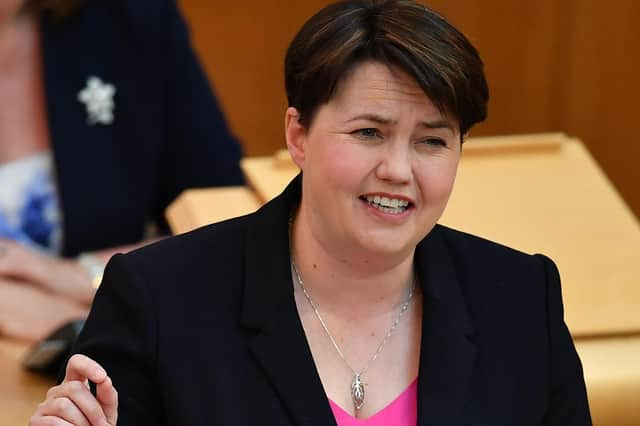Ruth Davidson returns but will soon be gone again: what voters see is not what they will get


RUTH Davdison is about to make a dramatic return to frontline politics. A year after bowing out as Scottish Conservative leader, wanting to spend more time with her 10-month old son and admitting to “conflict” over Brexit, the 41-year-old MSP for Edinburgh Central is taking charge once again of the Tories’ attacks on the SNP at Holyrood.
Her unexpected re-emergence as the face of the Tories in the Scottish Parliament comes after her successor Jackson Carlaw was ousted as leader and replaced by Douglas Ross, who was an MSP for just a year before switching focus and getting elected to Westminster.
Advertisement
Hide AdAdvertisement
Hide AdShe’s going to be standing in for him at First Minister’s Questions until he can return at next year’s election.
Ms Davidson worked wonders for the Scottish Tories when she was their leader, winning a record 31 MSPs at the 2016 elections, which meant they overtook Labour to become the main opposition party at Holyrood, and then taking them from one MP to 13 in the 2017 Westminster election.
After quitting she backed Mr Carlaw, who had been her deputy, to take over. He saw the party through last year’s general election as acting leader and was elected to the post in February after most of his potential rivals stood aside. Despite the loss of seven seats at the election, Tories at Holyrood felt he had fought a good campaign and party members thought it could have been a lot worse.
But a switch of tactics on Covid - from consensual to combative - without much impact, together with a surge in public support for independence seems to have been enough to persuade senior Tories it was time for a change.
Advertisement
Hide AdAdvertisement
Hide AdWith the next Holyrood election just nine months away, it looks a little like panic. It is always difficult for an opposition leader to get the pitch right in a national crisis; and crises can also lead to sudden swings in public opinion that may change again later. Mr Carlaw has proved his loyalty to the party by falling on his sword, but will a change of leader make any difference?
The unopposed appointment of Mr Ross also raises the question: were none of the party’s MSPs good enough for the job? Luckily for him, Ms Davidson is still around and willing to cover for him.
The arrangement has been likened to the role Nicola Sturgeon filled after Alex Salmond had been elected SNP leader for the second time in 2004 while an MP at Westminster and had to wait for the 2007 Holyrood election to return as an MSP - and First Minister.
But it could also be compared to the situation Labour had after Jim Murphy was elected Scottish Labour leader in 2014 but without a seat at Holyrood and his deputy Kezia Dugdale had to hold the fort at the Scottish Parliament. That did not end so happily for Mr Murphy. Before he had the chance to get into Holyrood at the elections, he lost his Westminster seat as Labour fell from 41 MPs to just one at the 2015 general election.
Advertisement
Hide AdAdvertisement
Hide AdMr Ross is almost guaranteed election to the Scottish Parliament via the Highlands and Islands list, but there is nothing certain about his party’s performance.
Ms Davidson proved so successful because she was not see as a “typical Tory” - but her return now is only temporary as a stand-in for Mr Ross. Then she’s quitting as an MSP and she’ll be off to the House of Lords
Voters impressed by her need to remember what they see over the next few months is not what they will get longer term.
Comment Guidelines
National World encourages reader discussion on our stories. User feedback, insights and back-and-forth exchanges add a rich layer of context to reporting. Please review our Community Guidelines before commenting.